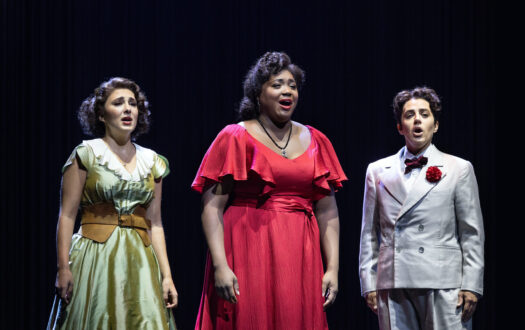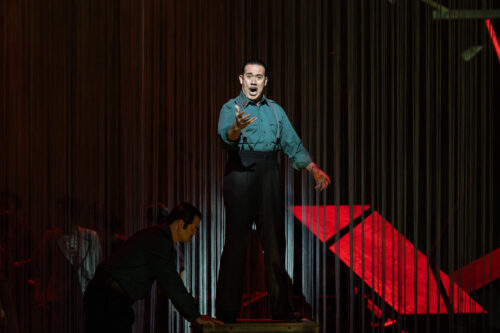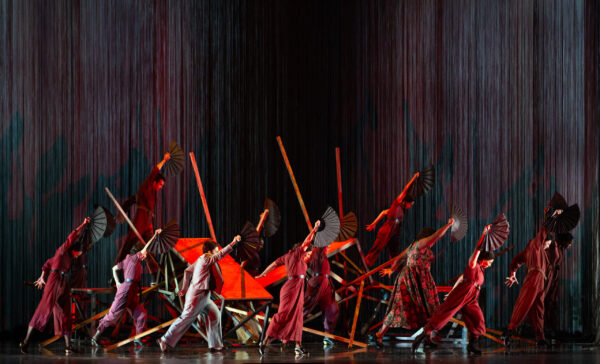 United States Golijov, Ainadamar: Soloists, Chorus, Orchestra of the Metropolitan Opera / Miguel Harth-Bedoya (conductor). Metropolitan Opera, New York, 6.11.2024. (ES-S)
United States Golijov, Ainadamar: Soloists, Chorus, Orchestra of the Metropolitan Opera / Miguel Harth-Bedoya (conductor). Metropolitan Opera, New York, 6.11.2024. (ES-S)

Osvaldo Golijov’s Ainadamar, first performed in 2003 at Tanglewood and presented in New York in a 2006 production by Peter Sellars, has finally arrived at the Metropolitan Opera. A poignant fantasia based on moments from the life of poet and playwright Federico García Lorca, Ainadamar serves as a powerful memorial to those who perished, including Lorca himself, at Granada’s ‘Fountain of Tears’ (‘Ainadamar’ in Arabic) at the outset of the Spanish Civil War. Golijov and librettist David Henry Hwang conceived an opera that unfolds through a series of recollections.
An ailing Margarita Xirgu (Angel Blue), a celebrated Spanish actress and Lorca’s former muse, is now in exile decades after his death and preparing for her final performance. Reminiscing with her protégé, Nuria (Elena Villalón), Margarita vividly recalls her past and her deeply felt relationship with Lorca (mezzo-soprano Daniela Mack in a trouser role). She remembers her first encounter with the poet in a Madrid bar, and her portrayal of Mariana Pineda, the nineteenth-century liberal heroine martyred in 1831 and the protagonist of Lorca’s first successful play of the same name. She reiterates her inability to persuade Lorca to escape to Cuba while he still had the chance and envisions his arrest by the Falangist Ramón Ruiz Alonso and subsequent execution. Finally, unable to perform and on her deathbed, Margarita has a vision of Lorca entering the room, taking her hands and Nuria’s, and thereby helping to transfer her courage, humanity and fighting spirit to the younger generation as represented by Nuria.

The creators have imbued Ainadamar, a work with a fragmentary dramatic structure that is both linear and non-linear, with Passion play connotations (Golijov’s most celebrated work was his 2000 La Pasión Según San Marcos). Not only do they assign missionary traits to the figures of Lorca and Mariana Pineda but, with the staging team’s assistance, they assimilate Lorca’s execution – flanked by a bullfighter and a teacher – with the scene at Golgotha. It was the most gripping image in a production brimming with symbolic details.
Director Deborah Colker and her team made their Metropolitan Opera debuts in this production, the most striking element of which is a suspended circular curtain composed of individual strings. Designed by Jon Bausor and dramatically lit by Paul Keogan, it evokes a quintessential Mediterranean interplay between outdoor/indoor and public/private spaces, while highlighting the temporal fluidity and dreamlike quality of the narrative approach. Serving as a projection screen for Tal Rosner’s soft-edged, unobtrusive video art – with images ranging from drops of water to close-ups of Margarita to scenes of mass mourning – it stands as a powerful metaphor for the ‘Fountain of Tears’ itself.
Dance, more than theatrical drama, is the backbone of the show. Deborah Colker, known for her productions for Cirque du Soleil, instructed everyone within and around the space delineated by the mesh-like curtain to always stay in motion, including the vocal soloists and the troupe of ‘Niñas’ – dancers/singers who play the role of the antic chorus. She enlisted choreographer Antonio Navarro to create flamenco-specific dance sequences which, full of passion yet hieratic, melded well with the fluid scenery and Golijov’s music with its ever-shifting focus.
As expected from the Argentine-born composer, the soundscape was a mixture of classical, jazz, flamenco and klezmer music with modernistic tinges. In addition, Golijov incorporated pre-recorded sequences of water drops falling, rapid gunfire and excerpts from fascist radio transmissions during the Spanish Civil War. Some combinations – such as the harp, vibraphone, celesta, strings and dripping water that accompany a multi-stream chorus in the description of the fountain – seemed to delicately blur the boundaries between the observed and the musical, while others felt overly prolix.
Also making his debut at the Metropolitan (but having conducted the opera before), Miguel Harth-Bedoya led the orchestra with attention, integrating all the details into a cohesive whole. The classically trained instrumentalists still seemed unsure, even after several performances, about how to tackle various aspects of the eclectic score. In composing an opera rooted in the spirit of flamenco, Osvaldo Golijov didn’t simply transpose the music for a symphonic orchestra: he reserved specific spaces in the pit and onstage for flamenco instrumentalists, singers and dancers.
The apparition of dancer Isaac Tovar, bathed in a spotlight at the beginning of the performance, became a vivid conduit for the spirit of ‘duende’ – the mysterious emotional expression that Lorca described as being ‘a force not a labor, a struggle not a thought’. Equally evocative was the ‘cante jondo’ or deep song of Alfredo Tejada, a flamenco ‘cantaor’, embodying the villainous Nationalist Ramón Ruiz Alonso. As he arrests Lorca, Tejada’s repeated cry, ‘Entréguenlo!’ (‘Surrender him!’) carried the spine-tingling visceral impact of a knife twisting in an open wound. His wailing utterances sharply contrasted with the more controlled operatic techniques of the other three main characters.
Soprano Angel Blue as Margarita Xirgu responded to Tejada’s powerful laments with her own graceful touches. Her warm, plush voice, though capable of suggesting anguish, began to show signs of fatigue toward the end, particularly during her meant-to-be triumphant rendition of ‘Yo soy la Libertad’. Elena Villalón displayed her penetrating yet tender voice as Nuria, a role that, despite feeling underdeveloped, she elevated with her fearless approach. In an opera dominated by female voices, mezzo-soprano Daniela Mack was convincing as Lorca himself (a character not explicitly present in the opera’s original version but added later), conveying a blend of vulnerability and insouciance. Her mellow, charming voice bloomed beautifully during the ‘Desde mi ventana’ aria.
Despite some incongruities, the production of Golijov’s Ainadamar – blending music, ballet, painting-inspired tableaux vivants and video projections – stands as one of the most remarkable achievements in General Manager Peter Gelb’s ongoing effort to bring contemporary opera to the Met.
Edward Sava-Segal
Featured Image: A scene from Golijov’s Ainadamar © Marty Sohl/Met Opera
Production:
Libretto – David Henry Hwang
Director & Choreographer – Deborah Colker
Sets & Costumes – Jon Bausor
Lighting – Paul Keogan
Projection – Tal Rosner
Sound – Mark Grey
Flamenco choreographer – Antonio Najarro
Chorus director – Tilman Michael
Cast:
Margarita Xirgu – Angel Blue
Nuria – Elena Villalón
Federico García Lorca – Daniela Mack
Ramón Ruiz Alonso – Alfredo Tejada
Voices of the Fountain – Jasmine Muhammad, Gina Perregrino
José Tripaldi – Scott Conner
Bullfighter – Eleomar Cuello
Teacher – Federico de Michelis
Solo flamenco dancers – Isaac Tovar, Sonia Olla
Onstage cajón – Gonzalo Grau
Onstage guitar – Adam del Monte
